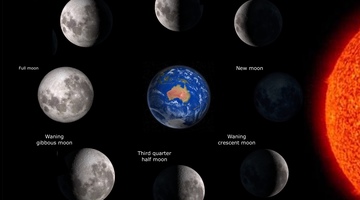Although the Moon appears to change during the lunar month, it is always the same shape. What does change is how much of the Moon we see from Earth, due to light and shadow.
Points for discussion:
- ‘Phase’ is a scientific term describing what something looks like. Phases of the Moon refer to what the Moon looks like when we view it from Earth at different times of the lunar month.
- Scientists use models to explain things that we cannot experience first-hand. This video uses physical models – a light and a white ball, and it uses animated models to help us visualise the orbits of the Earth and the Moon.
Transcript
NARRATOR
I’m sure you’ve noticed that the moon changes shapes – but do you know why?
For this, I’m going to use a model to show you. In my model, my face is the Earth, my Moon is this ball and my light is the Sun. In this model, everything is moving. The Earth is turning around its own axis. The Moon is orbiting around the Earth. And the Earth is orbiting around the Sun. Obviously a model isn’t the real thing – things would be much bigger and further apart, but it does have some uses.
We’re trying to figure out the phases of the Moon.
The first thing we need to know is that the Moon doesn’t create its own light. It’s lit from the Sun. As you can see here, this side of the Moon is lit by the Sun and this side is dark.
Now have a look – what happens when we line ourselves up so we’ve got the Sun, the Earth, and the Moon. When the Moon is between the Sun and the Earth, the side of the Moon that we’re seeing is in total darkness. This is called the new moon. The Moon is there, but the side that’s reflecting the Sun’s light is facing away from Earth.
As the Moon moves around Earth in its orbit, the light reflecting off the side of the Moon creates a sliver of shape. This is a crescent moon. Because it’s getting bigger, we can also call it the waxing crescent moon.
As the moon keeps moving, we see more of that light. At a quarter of the way around, we see half of the lit side of the Moon. This is the first quarter moon.
As we keep moving, the shape we’re seeing gets bigger. This is called the gibbous moon. Because the lit part is getting bigger, we can also call this the waxing gibbous moon.
At half-way around the orbit, we can see the entire half of the Moon. This is the full moon.
The Moon continues to orbit, and we start seeing less and less of the lit side. We’re back at the gibbous moon. Because it’s getting smaller, we call it a waning gibbous moon.
Then we get to the last quarter moon – which is confusing because it looks like a half moon, but it’s three quarters of the way through its orbit.
We get another crescent moon – a waning crescent moon because it's getting smaller.
And then back to another new moon.
And the cycle starts again.
Acknowledgements
Jayden Buntting
Night sky background, European Southern Observatory (ESO), CC-BY 4.0
Animated map of the Sun’s surface, NASA JPL


